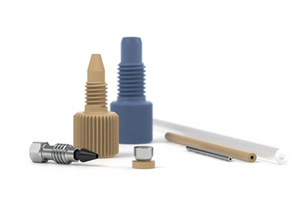Posted by Chrom Tech on 14th Oct 2025
How do Stainless-Steel Fittings Differ from Polymer-Based Fittings?
Both stainless-steel and polymer-based fittings are widely used in HPLC systems, each offering distinct advantages depending on the laboratory’s pressure requirements, sample type, and analytical goals. Understanding the key differences between these fitting materials helps ensure optimal performance, longevity, and safety in your chromatography setup.
Tightening Methods and Ease of Use
A primary difference between stainless-steel and polymer (such as PEEK) fittings lies in how they are tightened. Stainless-steel fittings are secured by “swaging” the ferrule onto the tubing using a wrench. This creates a highly durable, leak-free connection that can handle elevated pressures. However, the ferrule becomes permanently attached to the tubing—meaning that once it’s tightened, that section cannot be reused.
In contrast, polymer fittings such as PEEK are preferred for their ease of assembly. These fittings are typically finger-tightened, eliminating the need for tools and reducing the risk of overtightening or damaging tubing. This makes PEEK fittings an excellent choice for applications that require quick setup, frequent adjustments, or user-friendly operation.
High-Pressure Applications
Because stainless-steel fittings are mechanically tightened and form a rigid metal-to-metal seal, they are ideal for high-pressure applications. In UHPLC systems that operate at extremely high pressures, stainless steel is essential—polymer fittings cannot safely withstand such force without risk of deformation or leakage.
For low-pressure applications (such as 1/4-28 threaded connections), polymer fittings are the most common and practical choice. These fittings are compatible with a range of low-pressure systems and are available in many configurations, while metal alternatives are typically limited in this pressure range.
Biocompatibility and Chemical Inertness
Polymeric materials—especially PEEK—offer exceptional biocompatibility and chemical inertness, making them ideal for bioanalytical and life science applications. PEEK fittings resist most organic solvents, acids, and bases, and can endure sterilization procedures without degradation. This makes them well-suited for handling biological samples, corrosive chemicals, or metal-sensitive compounds that could otherwise interact with stainless-steel surfaces.
In contrast, while stainless steel is robust and durable, it may not be suitable for all sample types. Some biological molecules can adsorb to metal surfaces, potentially altering analytical results. For such applications, polymer-based fittings provide a safer and more chemically neutral alternative.
Choosing the Right Fitting for Your Application
The decision between stainless-steel and polymer fittings ultimately depends on your lab’s pressure requirements, chemical environment, and biocompatibility needs. Stainless steel is the go-to option for high-pressure and mechanical stability, while polymer fittings like PEEK are ideal for convenience, corrosion resistance, and bioinert workflows.
If you’re uncertain which option best fits your chromatography setup, Chrom Tech’s team of chromatography product specialists can help you evaluate your application and recommend the best fitting material for your system’s performance and longevity.
Frequently Asked Questions About HPLC Fittings
When should I use stainless-steel fittings instead of PEEK fittings?
Stainless-steel fittings should be used in high-pressure environments, such as UHPLC, where mechanical strength and pressure resistance are critical. PEEK fittings are better suited for low-pressure or biocompatible applications.
Can I reuse stainless-steel fittings after they’ve been swaged?
No. Once a stainless-steel ferrule has been swaged onto tubing, it cannot be reused. A new section of tubing and a fresh ferrule must be used to ensure a secure seal.
Are PEEK fittings compatible with all solvents?
PEEK fittings are resistant to most solvents and chemicals but can be attacked by strong acids, halogenated solvents, or concentrated sulfuric acid. Always check solvent compatibility before use.

